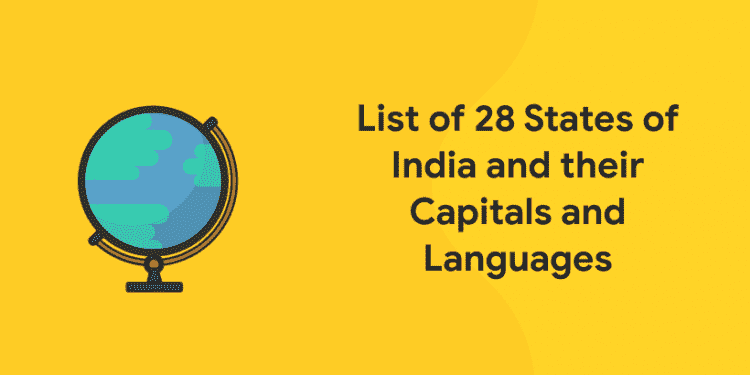Table of Contents
This article is about the states and capitals of India and the official languages for each state. “India is the cradle of the human race also the birthplace of human speech. The mother of history, the grandmother of legend also the great grandmother of tradition. Our most valuable and most constructive materials in the history of man are treasured up in India only” -Mark Twain
India is the second most populated and the seventh largest country and the most populous democracy in the world. It is located in South Asia. The country now has 28 number of states in total, along with 8 union territories, as of January 26, 2020. The capital city of India is Delhi. The state Jammu and Kashmir are converted into two union territories Jammu and Kashmir and Ladakh with effect from 31 October 2019. The union territories of Daman and Diu, Dadra and Nagar Haveli have become a single union territory since 26 January 2020 through a bill passed by Parliament.
List of States and Capitals of India – PDF Download
Click below link to download list of states and capitals of India PDF
Indian Geography
Geography of India: The Republic of India is the seventh-largest country in the world by its total area and has the second-largest population in the world. Being the largest democracy and one of the oldest civilizations in the world, India has one of the richest and most vivid histories and heritage with an extraordinary culture.
India belongs to the continent of Asia and is bordered by the countries of Bangladesh, Bhutan, Burma, China, Nepal, and Pakistan. It stands apart from the rest of Asia, marked off as it is by mountains and the sea, which give the country a distinct geographical entity. Bounded by the Great Himalayas in the north, it stretches southwards and at the Tropic of Cancer, tapers off into the Indian Ocean between the Bay of Bengal on the east and the Arabian Sea on the west.
What makes India unique is definitely its ‘unity in diversity. It accommodates a diverse number of languages, religions and cultures.
India is a union of 28 states and capitals and 8 union territories in the country. Each state and union territory has an administrative, legislative and judicial capital. Union territories are administered by the president through an administrator appointed by him/her.
This section introduces you to the latest updated list of total states in India 2025, their state capital and languages.
How Many States In India?
1: Who was the first woman President of India?
There are 28 states and 8 Union territories in India. The states and union territories are further subdivided into different districts and smaller administrative divisions. Union Territories are governed by the President through an Administrator that he or she appoints and the Indian States are administered by Chief Ministers of India.
DAILY CURRENT AFFAIRS – FREE PDF
Free UPSKILLING Courses!
Take your first step toward mastering in-demand skills, acing interviews, and securing top-tier jobs with Entri's free upskilling courses.
Start Learning!List of 28 States and Capitals of India 2025
Here is the complete list of states and capitals of India, updated on 26th January 2022.
| Sl. No. | States | Capital | Founded on |
| 1 | Andhra Pradesh | Amaravati | 1 Nov. 1956 |
| 2 | Arunachal Pradesh | Itanagar | 20 Feb. 1987 |
| 3 | Assam | Dispur | 26 Jan. 1950 |
| 4 | Bihar | Patna | 26 Jan. 1950 |
| 5 | Chhattisgarh | Raipur | 1 Nov. 2000 |
| 6 | Goa | Panaji | 30 May. 1987 |
| 7 | Gujarat | Gandhinagar | 1 May. 1960 |
| 8 | Haryana | Chandigarh | 1 Nov. 1966 |
| 9 | Himachal Pradesh | Shimla | 25 Jan. 1971 |
| 10 | Mizoram | Aizwal | 20 Feb. 1987 |
| 11 | Jharkhand | Ranchi | 15 Nov. 2000 |
| 12 | Karnataka | Bangalore | 1 Nov. 1956 |
| 13 | Kerala | Thiruvananthapuram | 1 Nov. 1956 |
| 14 | Madhya Pradesh | Bhopal | 1 Nov. 1956 |
| 15 | Maharashtra | Mumbai | 1 May. 1960 |
| 16 | Manipur | Imphal | 21 Jan. 1972 |
| 17 | Meghalaya | Shillong | 21 Jan. 1972 |
| 18 | Nagaland | Kohima | 1 Dec. 1963 |
| 19 | Odisha | Bhubaneswar | 26 Jan. 1950 |
| 20 | Punjab | Chandigarh | 1 Nov. 1956 |
| 21 | Rajasthan | Jaipur | 1 Nov. 1956 |
| 22 | Sikkim | Gangtok | 16 May. 1975 |
| 23 | Tamil Nadu | Chennai | 26 Jan. 1950 |
| 24 | Tripura | Agartala | 21 Jan. 1972 |
| 25 | Telangana | Hyderabad | 2 Jun. 2014 |
| 26 | Uttar Pradesh | Lucknow | 26 Jan. 1950 |
| 27 | Uttarakhand | Dehradun | 9 Nov. 2000 |
| 28 | West Bengal | Kolkatta | 1 Nov. 1956 |
Union Territories of India 2025
Currently, there are 8 union territories and their capitals we have. Dadra & Nagar Haveli and Daman & Diu and Jammu & Kashmir are the new union territories formed in India
| Union Territories Names | Capital | Founded on |
| Andaman and Nicobar Islands | Port Blair | 1 Nov. 1956 |
| Chandigarh | Chandigarh | 1 Nov. 1966 |
| Dadra & Nagar Haveli and Daman & Diu | Daman | 26 Jan. 2020 |
| Delhi | New Delhi | 9 May. 1905 |
| Jammu and Kashmir | Srinagar (Summer) Jammu (Winter) |
31 Oct 2019 |
| Lakshadweep | Kavaratti | 1 Nov. 1956 |
| Puducherry | Pondicherry | 1 Nov. 1954 |
| Ladakh | Leh | 31 Oct 2019 |
List of Official Languages of India for each States
Here is the list of languages in India for each state.
| Sl.No. | States | Language |
| 1 | Andhra Pradesh | Telugu and Urdu |
| 2 | Arunachal Pradesh | Miji, Apotanji, Merdukpen, Tagin, Adi, Honpa, Banging-Nishi |
| 3 | Assam | Assamese |
| 4 | Bihar | Hindi |
| 5 | Chhattisgarh | Hindi |
| 6 | Goa | Marathi and Konkani |
| 7 | Gujarat | Gujarati |
| 8 | Haryana | Hindi |
| 9 | Himachal Pradesh | Hindi and Pahari |
| 10 | Mizoram | Mizo and English |
| 11 | Jharkhand | Hindi |
| 12 | Karnataka | Kannada |
| 13 | Kerala | Malayalam |
| 14 | Madhya Pradesh | Hindi |
| 15 | Maharashtra | Marathi |
| 16 | Manipur | Manipuri |
| 17 | Meghalaya | Khashi, Jaintia
And Garo |
| 18 | Nagaland | Ao, Konyak, Angami, Sema and Lotha |
| 19 | Odisha | Oriya |
| 20 | Punjab | Punjabi |
| 21 | Rajasthan | Rajasthani and Hindi |
| 22 | Sikkim | Bhutia, Hindi, Nepali, Lepcha, Limbu |
| 23 | Tamil Nadu | Tamil |
| 24 | Tripura | Bengali, Tripuri, Manipuri, Kakborak |
| 25 | Telangana | Telugu, Urdu |
| 26 | Uttar Pradesh | Hindi |
| 27 | Uttarakhand | Hindi |
| 28 | West Bengal | Bengali |
Free UPSKILLING Courses!
Take your first step toward mastering in-demand skills, acing interviews, and securing top-tier jobs with Entri's free upskilling courses.
Start Learning!Capital of India 2025 – New Delhi
New Delhi, the political capital of India situated on the west bank of the Yamuna River. In December 1911 King George V of Britain moved the capital of British India from Calcutta (now Kolkata) to New Delhi. Today, New Delhi houses the supreme legislative body of the Republic of India the Indian parliament, the Indian Supreme Court, the Presidential House and many other union government offices. New Delhi is always the playground for the higher-level bureaucrats in the country.
The most populous city in the country, Mumbai accounts for 25% of industrial output, 5% of India’s GDP and also 70% of the capital transactions in the Indian economy. major Indian financial institutions such as the central bank of India the Reserve Bank of India, the Bombay Stock Exchange Market, and the corporate headquarters of many Indian banks and companies have Mumbai as their headquarters. Today this enticing Indian city is considered the Financial, Commercial and Entertainment capital of India. This industrial hub of India attracts lakhs of migrants towards her making the city of the densely populated city in the world.
Difference between State and Union Territories
Article 1 of the Indian constitution, defines India as the Union of States. On administrative terms, today after the inclusion of Jammu and Kashmir, and Ladakh there is a total of 28 states of India and 9 Union Territories. Let’s discuss the major differences between these two administrative forms:
- 29 States are the administrative unit that has their own elected government, which has the right to frame its laws, its own Legislative Assembly and the Chief Minister, for administration. In states, the Governor will act as the representative of the President. There is a clear distribution of powers and responsibilities among the centre and state. States do enjoy a certain amount of autonomy.
- Following the 1956 States re-organization commission recommendation, the economically unbalanced, financially weak, and administratively and politically unstable territories that can’t survive as separate administrative units without depending heavily on the Union government is formed as the Union Territories.
- A union territory is directly governed by the central government with the Lieutenant Governor (LG) as the representative of the President. Unlike the states, they are not independent units.
- Delhi and Puducherry are the only two Union Territories that have an elected legislature and are governed by a Lieutenant Governor (LG), Chief Minister, and council of ministers. These two UTs have been granted partial statehood, by an amendment to the Constitution. New Delhi is the only Union Territory with a high court.
- Andaman and Nicobar island was the first union territory of India.
This knowledge helps you to score well in your GK paper. General knowledge questions carry a comparatively high weightage of marks in the exams as compared to other subjects and even in the personal interview session that follows, the general awareness of the candidate is tested. So, acquire maximum general knowledge and enable yourself to face the exams with confidence.
Frequently Asked Question About the List of States and Capitals in India 2025
How many states are there in India in 2023?
Currently, there are 28 states in India.
How many union territories are there in India in 2022?
Currently, there are a total of 8 union territories in India.
Which are the 8 union territories of India?
Andaman and Nicobar Islands, Chandigarh, Dadra & Nagar Haveli and Daman & Diu, Delhi, Jammu and Kashmir, Lakshadweep, Puducherry and Ladakh are the 8 union territories of India.
What is the capital of India?
New Delhi is the capital of India.
How many districts are there in India?
As of 2022, there is a total of 718 districts in India.
How many cities are there in India?
There are 4000 cities and towns in India
Which state has the highest number of districts in India?
Uttar Pradesh has the highest number of districts in India (75).
Union territories which were merged in January 2020?
Daman and Diu were merged with Dadar and Nagar Haveli.
Which state was bifurcated in 2020 into two union territories?
Jammu and Kashmir are bifurcated into Jammu and Kashmir and Ladakh Union Territories.












